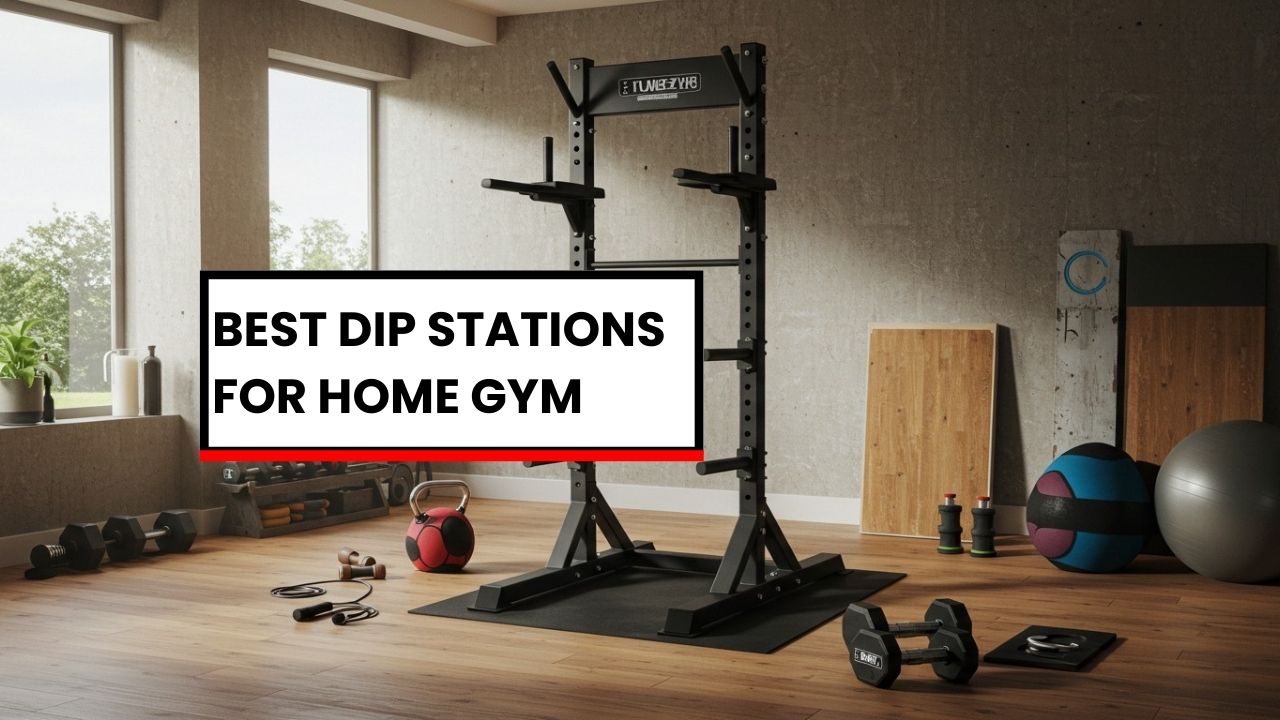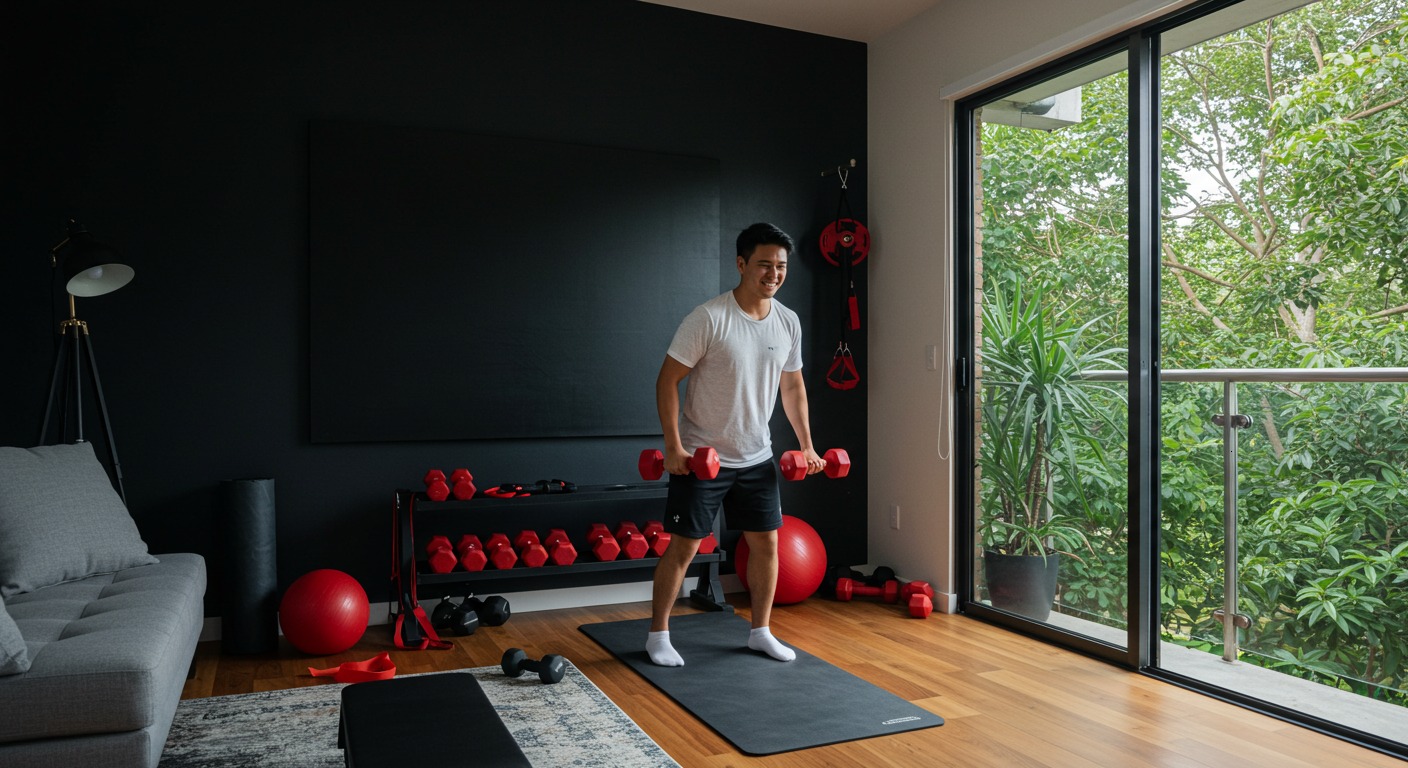Disclosure Information
This blog contains affiliate links. If you make a purchase through one of these links, our team may earn a commission at no extra cost to you. Learn more. Thanks for your support!
Building strength in your upper body requires the right equipment. Among the most versatile tools for developing your chest, shoulders, triceps, and core is a quality dip station. This essential piece transforms home workouts, allowing you to perform compound movements that engage multiple muscle groups simultaneously.
For home gym enthusiasts looking to maximize their training space and results, a dip station represents an excellent investment. Unlike many bulkier machines, these relatively compact pieces offer tremendous value through exercise variety and efficiency.
According to a recent fitness industry report, home gym equipment sales have increased by 218% since 2020, with strength training equipment leading this growth (source: Fitness Industry Association, 2024).
In this comprehensive guide, we’ll explore everything you need to know about dip stations – from their benefits and types to selecting the perfect one for your space and fitness goals.
The Quick Overview: Best Dip Stations
- Best Overall Standalone: Ultimate Fitness Pro Bars
- Best Heavy-Duty Option: StrongTek Heavy-Duty Station
- Best Space-Saver: Titan Fitness Parallel Bars
- Best Multi-Function Tower: Fitness Reality X-Class
- Best Budget Tower: BodyVision PT500 Tower
- Best Portable Option: Ultimate Body Press
- Best Wall-Mounted: Rogue Fitness Wall Mount
- Best Power Rack Attachment: Rep Fitness Dip Attachment
Benefits of Using a Dip Station
Complete Upper Body Development
Dip stations primarily target your triceps, chest, and shoulders. Regular dip exercises create balanced muscle development across these important upper body areas, helping you achieve a proportionate physique.
The pressing motion in dips engages your pectorals deeply, comparable to bench pressing. This makes dips exceptional for chest development when performed with proper form and the right forward lean.
Functional Strength Gains
Dips build practical, usable strength that transfers to everyday activities. By mimicking natural pushing movements, they improve your ability to lift, push, and manipulate objects in real-world scenarios.
Unlike isolated machine exercises, dips require your body to stabilize itself throughout the movement. This coordination develops functional fitness that’s applicable beyond the gym.
Versatility in Programming
A study examining exercise variation found that individuals who incorporated multiple dip variations showed 27% greater strength improvements than those using single-movement protocols (source: Journal of Strength Conditioning, 2023).
From beginner modifications to advanced weighted variations, dip stations accommodate all fitness levels. You can easily adjust difficulty by changing your body position or adding resistance.
Space and Cost Efficiency
For home gym users, dip stations offer exceptional value. They typically require minimal floor space while providing exercises that would otherwise demand multiple machines or equipment pieces.
The cost-per-exercise ratio makes dip stations among the most economical strength training investments. Most quality options remain affordable compared to comprehensive weight machines.
Types of Dip Stations
1. Standalone Dip Bars
Standalone dip bars represent the most traditional dip station design. These independent structures consist of two parallel bars mounted on a stable base.
Pros:
- Dedicated design optimized specifically for dip exercises
- Typically allow for greater exercise range of motion
- Generally more stable than combination units
- Often include features like angled grips for comfort
Top Recommendations:
| Model | Weight Capacity | Special Features |
| Ultimate Fitness Pro Bars | 500 lbs | Angled comfort grips |
| StrongTek Heavy-Duty Station | 400 lbs | Extra wide base |
| Titan Fitness Parallel Bars | 600 lbs | Commercial-grade steel frame |
The Ultimate Fitness Pro Bars stand out for serious trainees. Their exceptional stability and comfort-oriented design make even lengthy workouts comfortable on wrists and shoulders.
For those prioritizing durability, the StrongTek Heavy-Duty Station offers excellent value. Its reinforced joints and wide base ensure wobble-free performance even during dynamic movements.
Home gym owners with limited space might prefer the Titan Fitness Parallel Bars. Despite their commercial-grade construction, they feature a relatively compact footprint.
2. Power Tower Dip Stations
Power towers combine dip stations with pull-up bars and sometimes additional features like push-up handles or knee raise stations.
Pros:
- Multi-functional design addresses multiple exercise needs
- Excellent space efficiency for comprehensive workouts
- Usually height-adjustable for different users
- Often more affordable than buying separate equipment
Top Recommendations:
| Model | Functions | Construction Quality |
| Fitness Reality X-Class | 5 stations | Commercial grade |
| BodyVision PT500 Tower | 4 stations | Heavy steel frame |
| Sportsroyals Power Tower | 6 stations | 400 lb capacity |
The Fitness Reality X-Class represents the premium option in this category. Its rock-solid construction and generous workout space make it suitable for intense training sessions.
Budget-conscious users will appreciate the BodyVision PT500 Tower. It delivers essential functionality without unnecessary bells and whistles that drive up cost.
For those wanting maximum versatility, the Sportsroyals Power Tower includes uncommon features like a dedicated ab bench and adjustable dip station heights.
3. Foldable/Portable Dip Stations
These lightweight, collapsible options provide dip functionality without permanent space commitment. They’re ideal for apartments or shared workout spaces.
Pros:
- Easy storage when not in use
- Transportable for outdoor workouts
- Generally more affordable than permanent stations
- Quick setup and takedown
Top Recommendations:
| Model | Folded Size | Weight Capacity |
| Ultimate Body Press | 16″ × 24″ | 350 lbs |
| Lebert Fitness Equalizers | 28″ × 8″ | 250 lbs |
| ProsourceFit Dip Stand | 20″ × 23″ | 300 lbs |
The Ultimate Body Press stands out for its impressive stability despite its portable nature. The unique locking mechanism prevents unwanted movement during exercises.
For travelers or those with minimal storage, the Lebert Fitness Equalizers pack down exceptionally small while maintaining adequate functionality for effective workouts.
The ProsourceFit Dip Stand offers the best balance of affordability and performance. Its streamlined design focuses on essentials without sacrificing stability.
4. Wall-Mounted Dip Stations
These space-saving options attach directly to wall studs. They provide dip functionality without floor footprint and can sometimes be folded against the wall when not in use.
Pros:
- Zero floor space requirement
- Extremely stable when properly installed
- Clean, minimalist aesthetic
- Some models fold away when not in use
Top Recommendations:
| Model | Extension From Wall | Installation Difficulty |
| Rogue Fitness Wall Mount | 24 inches | Moderate |
| PRx Performance Profile | 26 inches | Easy |
| Titan Wall-Mounted Dip | 22 inches | Moderate |
The Rogue Fitness Wall Mount represents commercial-grade quality for home use. Its overbuilt construction ensures years of heavy use without concerns.
For those wanting maximum space efficiency, the PRx Performance Profile folds completely flat against the wall when not in use.
Budget-conscious users will appreciate the Titan Wall-Mounted Dip station. It delivers essential functionality at approximately half the cost of premium alternatives.
5. Dip Attachments for Power Racks
These attachable bars connect to existing power racks or squat stands, adding dip functionality to equipment you may already own.
Pros:
- Excellent option for those who already own a power rack
- Typically more affordable than standalone stations
- Leverages existing equipment footprint
- Often adjustable to different heights
Top Recommendations:
| Model | Compatibility | Attachment Method |
| Rep Fitness Dip Attachment | Universal | Y-dip design |
| Rogue Matador | 2×2″ and 3×3″ | Single-point mounting |
| Titan Y Dip Bar | Most 2″ racks | Dual-point connection |
The Rep Fitness Dip Attachment offers exceptional versatility, fitting virtually any power rack on the market through its innovative design.
For maximum stability, the Rogue Matador stands out with its single-piece construction and precision manufacturing that eliminates wobbling.
Value-focused lifters will appreciate the Titan Y Dip Bar, which delivers comparable performance to premium options at a significantly lower price point.
How to Choose the Right Dip Station
Consider Your Space
Evaluate your available workout area honestly before selecting a dip station. Measure both floor space and ceiling height if considering options with vertical components.
Remember to account for movement space around the equipment. You’ll need clearance for your body during exercises, not just the footprint of the station itself.
For extremely limited spaces, wall-mounted options or power rack attachments may represent your best solution. These minimize dedicated floor space requirements.
Assess Your Training Goals
Your specific fitness objectives should guide your dip station selection. For comprehensive calisthenics training, power towers offer valuable versatility.
If your focus lies primarily on bodybuilding or targeted strength development, standalone stations typically provide superior stability for weighted exercises.
Those incorporating dips within broader functional fitness routines might benefit most from power rack attachments that integrate with existing equipment.
Evaluate Construction Quality
A 2024 survey of home gym equipment owners found that 67% consider durability their top priority when making purchase decisions (source: Home Fitness Forum, 2024).
Check weight capacities carefully, especially if you plan to perform weighted dips. Quality stations typically support at least 300 pounds, with premium options exceeding 500 pounds.
Examine connection points and welds on metal frames, as these represent common failure points. Reputable manufacturers provide clear images of these critical areas.
Consider Your Experience Level
Beginners might benefit from stations with additional features like assistance bands or multiple grip options. These make progression more manageable.
Advanced lifters should prioritize stability and durability above all else. Your dip station should accommodate weighted variations without concerning movement.
For those between levels, adjustable options offer valuable flexibility as your capabilities develop over time.
How to Use a Dip Station Effectively
Proper Dip Form
Maintaining proper form prevents injury while maximizing results. Begin with shoulders down and back, core engaged, and a slight forward lean for chest emphasis.
Lower yourself until your upper arms reach parallel with the ground. Going deeper increases range of motion but may stress shoulders unnecessarily for beginners.
Control both the descent and ascent phases. Explosive movements increase injury risk without providing significant additional training benefits.
Progressive Overload Strategies
Like any exercise, dips require progressive overload for continued development. Begin with assisted variations if necessary, using bands or partner assistance.
Once standard dips become manageable, increase difficulty by adding repetitions, extending time under tension, or introducing additional weight via dip belts.
For advanced trainees, consider implementing techniques like tempo manipulation, drop sets, or mechanical advantage variations to drive further progress.
Sample Dip Station Workout
Beginner Routine:
- Assisted dips: 3 sets of 8-10 reps
- Negative dips: 2 sets of 5 reps (controlling descent phase)
- Straight bar holds: 3 sets of 20-30 seconds
Intermediate Routine:
- Standard dips: 4 sets of 10-12 reps
- Weighted dips: 3 sets of 6-8 reps
- Russian dips: 2 sets of 8 reps
Advanced Routine:
- Weighted dips: 5 sets of 5 reps (heavy loading)
- Ring dips: 3 sets of 8-10 reps
- Planche dip progressions: 3 sets of 5-8 reps
Maintenance and Care Tips
Regular Inspection
Check all connection points, bolts, and welds monthly for signs of wear or damage. Tighten any loose components immediately.
For portable units, pay special attention to folding mechanisms and locking devices. These moving parts typically wear faster than static components.
Wall-mounted options require periodic inspection of wall attachments and brackets. Even minor wall damage can compromise safety substantially.
Cleaning and Protection
Wipe down grip surfaces after use to prevent sweat accumulation and corrosion. A diluted vinegar solution works well for removing buildup.
Apply a light coating of silicone spray to moving parts quarterly. This prevents squeaking and ensures smooth operation of adjustable components.
For outdoor or garage units, consider rust-prevention strategies. These might include specialized coatings or covering equipment when not in use.
Conclusion
A quality dip station represents one of the most valuable investments for home fitness enthusiasts. Few pieces of equipment offer comparable versatility, effectiveness, and value in such a compact package.
By selecting the right station for your specific needs and using it consistently with proper form, you’ll develop impressive upper body strength that translates to both aesthetic improvements and functional capabilities.
Whether you choose a standalone unit, power tower, or space-saving alternative, regular dip training will deliver results that justify your investment many times over.
FAQs About Dip Stations
How much weight can typical dip stations support?
Most quality dip stations support between 300-600 pounds, including user weight and any additional resistance. Always check manufacturer specifications for your specific model.
Can beginners use dip stations effectively?
Absolutely. Beginners can start with assisted variations using resistance bands or partner help before progressing to standard dips.
What muscles do dip stations target?
Dips primarily work the triceps, chest (pectoralis major), and shoulders (anterior deltoid), with secondary engagement of the core and back muscles.
How much space do I need for a dip station?
Space requirements vary by type. Standalone units typically need about 4×3 feet of floor space, while wall-mounted options require zero floor space but approximately 4 feet of clearance from the wall.
Are dip stations safe for people with shoulder issues?
Those with existing shoulder problems should consult medical professionals before using dip stations. Modified ranges of motion and proper warm-up can make dips accessible for many, but not all conditions.


